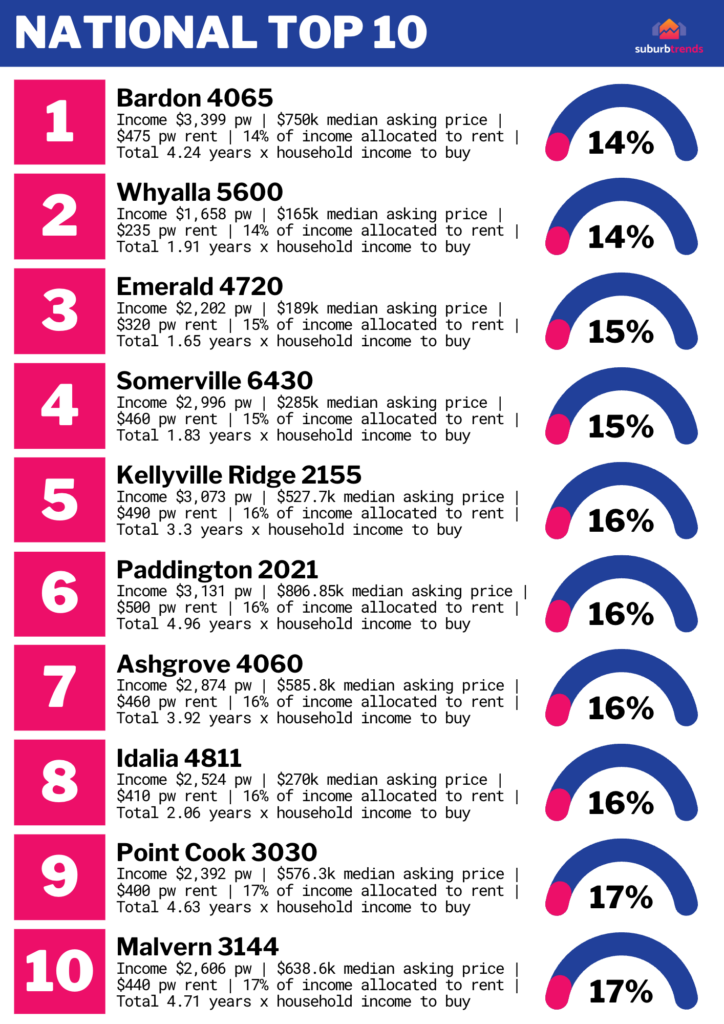Bardon, the leafy, green suburb in western Brisbane has topped a list of the nation’s most affordable suburbs.
The list, compiled by Suburbtrends, identified the 10 most affordable suburbs for renting or buying a unit.
Four Queensland suburbs made the national top 10, followed by two NSW suburbs, two in Victoria and one each in South Australia and Western Australia.
This unique study assessed affordability by comparing median household income levels against housing costs, providing a nuanced picture of real-world affordability.
This robust approach resulted in an unexpected list of suburbs where residents spend the smallest fraction of their income on rent or require the fewest years of income to purchase a property.
Notably, the list includes several upscale suburbs, highlighting the broad applicability of the findings.
In Bardon, tenants spend about 14 per cent of their $3399 per week income on rent, which sits at about $475 per week.
When buying a home in Bardon it takes 4.24 years of household income to meet the current median asking price of $750,000.
Suburbtrends Founder, Kent Lardner, highlighted the value of the findings:
“Our analysis reveals that, based on rentals and purchase prices relative to income, Australians can find affordable units across the nation,” he said.
“We located 148 suburbs offering units for rent at less than 30% of household income and are available to purchase at less than five times annual income levels.”

Mr Lardner further stressed the significance of affordable housing.
“Affordable housing fuels our economy,” he said.
“When families are not burdened by housing costs, they can contribute more to the economy, benefiting both individual households and the broader economy.
“Affordable housing is a vital tool against homelessness and poverty.
“Access to affordable housing promotes stability and resilience, reducing the risk of homelessness and providing a path out of poverty.”
The coastal South Australian city of Whyalla was the second most affordable location on a national scale, with tenants there also spending about 14 per cent of their income ($1658pw) on rent, which sits at $235 per week for units.
Buying a unit takes 1.91 years of household income, with a median asking price of $165,000.

To deliver the comprehensive guide, Suburbtrends employed a rigorous methodology, with median property asking prices cross-referenced with median household income levels, using the most recent Census data and property listings from the past 12 months.
Rental affordability was assessed by determining the percentage of household income devoted to rent, with a 30 per cent threshold set as the maximum.
Purchase affordability was evaluated by comparing the number of years of household income needed to meet the median asking price. A five-year income limit was set for inclusion in the list.
Only suburbs with a minimum of five units listed for sale and a maximum vacancy rate of 2 per cent were considered, to ensure active property markets.
Suburbs were further filtered based on a maximum inventory level of five months’ worth of stock and a minimum socio-economic (SEIFA) score of four.
Notably, not all suburbs that made the lists were the cheapest places to rent or buy.
Paddington, in Sydney’s East made the national top 10 at number 4, while Greenwich, on Sydney’s Lower North Shore also made the Top 10 affordable suburbs in NSW, coming in at number 3.

